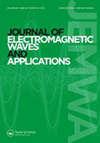包层模式干扰装置的设计——传感器主机和全光纤线性增益平坦化元件及宽带滤波器
IF 1.1
4区 工程技术
Q4 ENGINEERING, ELECTRICAL & ELECTRONIC
Journal of Electromagnetic Waves and Applications
Pub Date : 2023-09-21
DOI:10.1080/09205071.2023.2260367
引用次数: 0
摘要
摘要本文描述了如何利用不同芯级全光纤设计基于芯和包层模式的干涉和自成像器件。结构中芯径的不匹配激发了包层模式与芯模的不匹配,导致包层模式与芯模之间的渐进干涉成像,产生波长和折射率相关的损耗。通过系统研究,我们调整了器件参数,作为高性能光纤传感器,分别以0.0713 dB/°C和0.0372 dB/(% mL/mL)的灵敏度测量温度和浓度。接下来,我们优化了主机配置的波长敏感参数,研究了增益变化最大为0.91和0.97 dB的掺铒光纤放大器(edfa)作为增益平坦滤波器(GFF)在33和25 nm波长范围内的传输特性。最后,我们展示了一种可调谐的双平顶带抑制滤波器,其抑制带分别为14、26和46 nm。关键词:芯包层模式干涉光纤温度和浓度测量tedfa增益平坦带阻滤波器披露声明作者未报告潜在利益冲突数据可得性本研究中使用的信息是应作者要求提供的。protik Roy于2016年在印度西孟加拉邦加尔各答大学获得物理学学士学位,并于2018年在印度北方邦坎普尔印度理工学院获得理学硕士学位。2019年,他加入印度西孟加拉邦Kharagpur印度理工学院物理系,作为研究学者,从那时起,他一直在光学和光子学的广泛领域从事博士研究。他的主要研究兴趣是开发基于包层模式的器件和传感器。Partha Roy Chaudhuri是印度理工学院Kharagpur的物理学教授,从事光纤、集成光学和光子学领域的研究。2000年,他在德里印度理工学院光纤组获得博士学位。随后,他作为日本政府研究员在日本京都理工大学进行博士后研究,在那里他从事各种光波导和元件的研究。2002-2004年,他在新加坡国立大学通信研究所从事光子晶体光纤和器件的实验研究。2004年,他加入印度理工学院物理系。他目前的研究方向为微结构光纤/光子晶体波导和无源/有源/非线性应用器件,以及用于检测弱电场和磁场的光纤传感器的开发。本文章由计算机程序翻译,如有差异,请以英文原文为准。
Designing cladding mode interference device – a host for sensors and all-fiber inline gain-flattening component and broad-band filter
AbstractThis article describes how to devise interference and self-imaging of core and cladding modes based devices using dissimilar core concatenated all-fibers. The core diameter mismatch in the structure excites the cladding modes with the core mode that leads to a progressive interference imaging between the cladding modes and the core mode yielding wavelength and refractive index dependent loss. Through a systematic study, we tune the device parameters to gauge temperature and concentration with sensitivity of 0.0713 dB/°C and 0.0372 dB/(% mL/mL) respectively as a high-performance fiber sensor. Next, optimizing the wavelength sensitive parameters of the host configuration, we investigate the transmission characteristics as gain-flattening filters (GFF) of Erbium-doped fiber amplifiers (EDFAs) with maximum gain variations of 0.91 and 0.97 dB, for two different EDFAs respectively over a wavelength band of 33 and 25 nm. Finally, we demonstrate a tunable and two-flattop band rejection filters with rejection band of 14, 26 and 46 nm, respectively.KEYWORDS: Core–cladding mode interferencefiber optic temperature and concentration measurementEDFA gain flatteningband rejection filter Disclosure statementNo potential conflict of interest was reported by the author(s).Data availabilityThe information applied in this research is ready from the authors at request.Additional informationNotes on contributorsProtik RoyProtik Roy received his BSc degree in Physics from the University of Calcutta, West Bengal, India, in 2016 and his MSc degree from the Indian Institute of Technology, Kanpur, Uttar Pradesh, India in 2018. In 2019, he joined the Department of Physics, Indian Institute of Technology, Kharagpur, West Bengal, India, as a Research Scholar where since then, he has been working in the broad area of optics and photonics for this PhD research. His main research interest is to develop cladding mode based devices and sensors.Partha Roy ChaudhuriPartha Roy Chaudhuri is a Professor of Physics at Indian Institute of Technology Kharagpur, working in the area of Fiber and Integrated Optics and Photonics. In 2000, he did his PhD from the Fiber Optics Group of Indian Institute of Technology Delhi. He then pursued postdoctoral research at the Kyoto Institute of Technology, Japan, as a Japanese Government Fellow where he was working on various optical waveguides and components. Later, during 2002–2004, he worked at the Institute for Communications Research, NUS, in experimental research with photonic crystal fibers and components. In 2004, he joined the Faculty of the Physics Department, IIT Kharagpur, India. His current research interests are in the area of microstructured optical fibers/photonic crystal waveguides and devices for passive and active/nonlinear applications and development of fiber optic sensors for the detection of weak electric and magnetic fields.
求助全文
通过发布文献求助,成功后即可免费获取论文全文。
去求助
来源期刊
CiteScore
3.60
自引率
7.70%
发文量
116
审稿时长
3.3 months
期刊介绍:
Journal of Electromagnetic Waves and Applications covers all aspects of electromagnetic wave theory and its applications. It publishes original papers and review articles on new theories, methodologies, and computational techniques, as well as interpretations of both theoretical and experimental results.
The scope of this Journal remains broad and includes the following topics:
wave propagation theory
propagation in random media
waves in composites and amorphous materials
optical and millimeter wave techniques
fiber/waveguide optics
optical sensing
sub-micron structures
nano-optics and sub-wavelength effects
photonics and plasmonics
atmospherics and ionospheric effects on wave propagation
geophysical subsurface probing
remote sensing
inverse scattering
antenna theory and applications
fields and network theory
transients
radar measurements and applications
active experiments using space vehicles
electromagnetic compatibility and interferometry
medical applications and biological effects
ferrite devices
high power devices and systems
numerical methods
The aim of this Journal is to report recent advancements and modern developments in the electromagnetic science and new exciting applications covering the aforementioned fields.

 求助内容:
求助内容: 应助结果提醒方式:
应助结果提醒方式:


